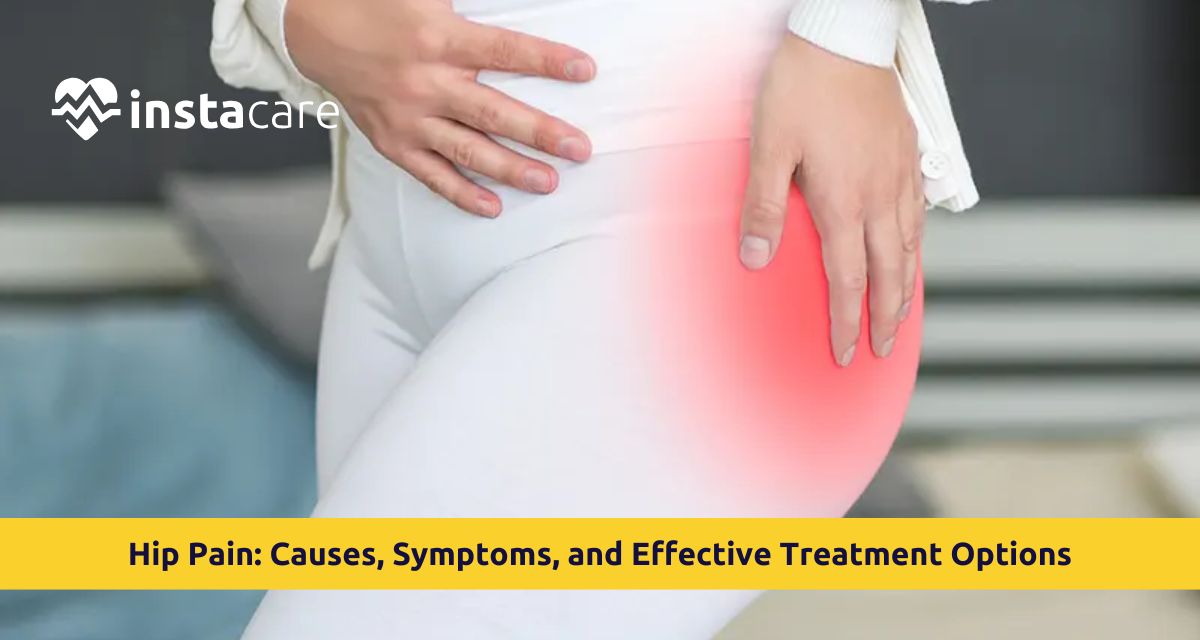The hip joint will carry the weight of a body. It connects the pelvic girdle and the thigh bone or femur. It allows walking, running or other movements and sitting with independent movement. Within certain limits, the joint allows a normal range of movements and is hence susceptible to excessive wear and tear, injury, and diseases in humans.
Anyone can develop pain in the hip, although it is most common in older people. It may be a pointer to some minor problem or something serious that may necessitate attention from a health professional.
What is Hip Pain?
The hip joint area demonstrates various symptoms such as discomfort together with soreness. The hip pain derives from various causes including injuries as well as overuse and arthritis and other health problems. Pain that arises from different causes will feel in various body locations ranging from the groin to the thigh and buttocks.
Some Common Causes of Hip Pain
There are various causes of hip pain. They can be either intra-articular or involve other associated structures such as muscles, tendons, or ligaments.
1. Arthritis
Among the important common causes of hip pains in the elderly, osteoarthritis,
rheumatoid arthritis, and psoriatic arthritis create inflammation of the healthy hip joint which causes deterioration of it.
2. Bursitis
In the healthy hip, there are several small sacs of clear fluid, known as bursae, where tissues can move past one another without friction. In contrast, if they become inflamed through repetitive or traumatic activity, they develop bursitis, which is severe pain.
3. Tendinitis
Most sprains around the hip are due to repetitive trauma and it mostly affects sportsmen or women or active people.
4. Hip fractures
Hip fractures are probably one of the most serious conditions associated with aged persons, often occurring after weakened bones or osteoporosis. They may follow falls or violent impacts.
5. Muscle or tendon strains
Strain occurs when muscles and tendons around the hip are overused. It is common among swimmers, dancers, and anyone who leads a very physical lifestyle.
6. Labral Tears
The labrum is a ring of cartilage that surrounds the entrance to the hip socket. A tear inside the labrum can produce pain, weakness, and limited range of motion arthritic in that specific hip joint instance.
Recognizing the Symptoms Early
Same as the causes or severity, the symptoms could show variability, but early recognition will guide you in seeking timely treatment.
● Stiffness: There is a restriction in freedom of movement in the hip joint, particularly after that long sleep at night or when one has sat too long.
● Swelling: There could usually be seen or felt inflammatory activity about the hip.
● Clicking and popping sounds: These noises can be produced when the joint moves.
● Limited movement range: Pain can limit your leg's full movement. Limping: Usually associated with pain or weakness in the hip.
When to Seek Medical Attention?
Minor hip pain can, in some cases, be self-resolving, but there are times that one should seek immediate medical attention.
● If the pain comes suddenly and very severe
● If inability to weight-bear on the leg
● If you fall or have an accident and suspect there is a fracture
● If it looks deformed or swelling overly
● If fever accompanies the pain (possible infective)
Diagnosis and imaging tests like X-rays and MRIs may be seen as needing to be done to find an exact cause.
Home-based Remedies for Mild Hip Pain
Hip pain from uses or strains is something you can treat, i.e., relieve, at home. Here are some easy methods to relieve discomfort:
● Rest: You should not burden the hip joint for a few days.
● Ice therapy: Place an ice pack on the hip for 15-20 minutes every few hours to lessen the inflammation.
● Heat Application: Afterward, once the inflammation is over, a warm compress should relax the hurt muscles.
● Over-the-counter medication: Ibuprofen or acetaminophen would help in pain.
● Gentle stretching: Eventually little should be done to loosen and keep from becoming stiff without straining.
Medical Treatments That Offer Relief
These treatments are offered for prosthesis management or to remove hip pain if home care has offered no relief.
● Physical therapy: A physical therapist will take you through exercises targeting the strengthening of the muscles around the hip and stretching.
● Prescription drugs: Anti-inflammatory medicines, muscle relaxants, or injections may be utilized for stronger pain relief.
● Steroid injections: Inject drugs to reduce inflammation and provide temporary pain relief.
● Surgical intervention: Hip replacements or arthroscopy are options for more severe conditions such as fractures or arthritis.
Excellent Lifestyle Changes for Achieving Long-Term Hip Health
Changes in lifestyle can pave the way for avoiding hip pain and mitigate the development of hip pain in one's life.
Healthy Weight Maintenance
Extra pounds excessively load a hip joint area. Even shedding 5–10 pounds reduces the stress on joints due to weight, relieving pain.
Regular Exercise
Muscle-toning exercises such as swimming and walking include activities that develop flexibility, like cycling with regard to joints.
Daily Stretching
Gentle stretches such as those for the hips and thighs help increase mobility with the added benefits of preventing stiffness.
Supportive Footwear
Shoes that have good cushioning and arch support will help to correct the posture and relieve stresses in the hips.
Avoid Long Sitting
By getting up and moving every half to hour, you can help lessen stiffness and improve
blood circulation.
Use Ergonomic Furniture
Chairs with proper back and hip support will protect those joints during work or relaxation from the stress they accumulate.
Strengthening the Muscles of the Core
The stronger the core, the more balance and alignment, and thus the load on the hips is decreased.
Physical Therapy Exercises That Help
Specific exercises are an effective way to help alleviate hip pain. That needs to be done under the guidance of a professional.
Bridging
Lie on your back, with knees bent and feet flat. Raise your hips toward the ceiling, hold, then slowly lower. This strengthens glutes and hamstrings.
Leg raises
While lying on your back or side, lift your leg slowly and lower it without touching the floor. It builds hip and thigh muscles.
Hip flexor stretch
Kneel one knee with the other foot advanced. Gently push your hips forward for a stretch on the front of your hip.
Clamshells
Lie on your side with your knees bent. Keeping your feet together, raise the top knee and slowly lower it with control. It activates your glutes.
Wall sits
Slide down your back against a wall until your knees are bent in a 90-degree angle. Hold this position to strengthen thigh and hip muscles.
How to Prevent Future Hip Problems?
Prevention is paramount when it comes to joints. Looking after your body on a daily basis can lower the risk for future hip problems. Routine examinations for older people or any patient with a family history of arthritis can catch the joint problems in the initial stages. Strength, posture, and nutrition are also of utmost importance for the health of the hip.
Final Thoughts
Hip pain may start with mild discomfort, but if neglected, can cause extreme restriction in function and lifestyle. With the right mix of medical intervention, home remedies, and lifestyle changes, you would be able to manage the problem of hip pain successfully and with greater physical activity.
Please book an appointment with the
best Orthopedic Surgeon in Lahore, Karachi, Islamabad, and all major cities of Pakistan through
InstaCare, or call our helpline at 03171777509 to find the verified doctor for your disease.

